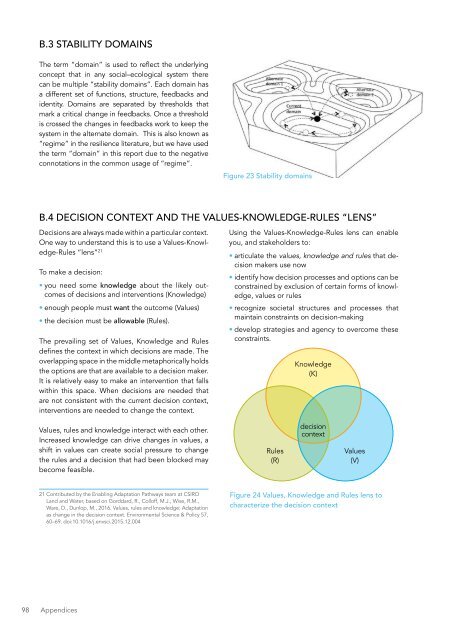DESIGNING PROJECTS IN A RAPIDLY CHANGING WORLD
srun3013fp1
srun3013fp1
You also want an ePaper? Increase the reach of your titles
YUMPU automatically turns print PDFs into web optimized ePapers that Google loves.
B.3 STABILITY DOMA<strong>IN</strong>S<br />
The term “domain” is used to reflect the underlying<br />
concept that in any social–ecological system there<br />
can be multiple “stability domains”. Each domain has<br />
a different set of functions, structure, feedbacks and<br />
identity. Domains are separated by thresholds that<br />
mark a critical change in feedbacks. Once a threshold<br />
is crossed the changes in feedbacks work to keep the<br />
system in the alternate domain. This is also known as<br />
“regime” in the resilience literature, but we have used<br />
the term “domain” in this report due to the negative<br />
connotations in the common usage of “regime”.<br />
Figure 23 Stability domains<br />
B.4 DECISION CONTEXT AND THE VALUES-KNOWLEDGE-RULES “LENS”<br />
Decisions are always made within a particular context.<br />
One way to understand this is to use a Values-Knowledge-Rules<br />
“lens” 21<br />
To make a decision:<br />
• you need some knowledge about the likely outcomes<br />
of decisions and interventions (Knowledge)<br />
• enough people must want the outcome (Values)<br />
• the decision must be allowable (Rules).<br />
The prevailing set of Values, Knowledge and Rules<br />
defines the context in which decisions are made. The<br />
overlapping space in the middle metaphorically holds<br />
the options are that are available to a decision maker.<br />
It is relatively easy to make an intervention that falls<br />
within this space. When decisions are needed that<br />
are not consistent with the current decision context,<br />
interventions are needed to change the context.<br />
Using the Values-Knowledge-Rules lens can enable<br />
you, and stakeholders to:<br />
• articulate the values, knowledge and rules that decision<br />
makers use now<br />
• identify how decision processes and options can be<br />
constrained by exclusion of certain forms of knowledge,<br />
values or rules<br />
• recognize societal structures and processes that<br />
maintain constraints on decision-making<br />
• develop strategies and agency to overcome these<br />
constraints.<br />
Knowledge<br />
(K)<br />
Values, rules and knowledge interact with each other.<br />
Increased knowledge can drive changes in values, a<br />
shift in values can create social pressure to change<br />
the rules and a decision that had been blocked may<br />
become feasible.<br />
Rules<br />
(R)<br />
decision<br />
context<br />
Values<br />
(V)<br />
21 Contributed by the Enabling Adaptation Pathways team at CSIRO<br />
Land and Water, based on Gorddard, R., Colloff, M.J., Wise, R.M.,<br />
Ware, D., Dunlop, M., 2016. Values, rules and knowledge: Adaptation<br />
as change in the decision context. Environmental Science & Policy 57,<br />
60–69. doi:10.1016/j.envsci.2015.12.004<br />
Figure 24 Values, Knowledge and Rules lens to<br />
characterize the decision context<br />
98 Appendices


